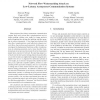Free Online Productivity Tools
i2Speak
i2Symbol
i2OCR
iTex2Img
iWeb2Print
iWeb2Shot
i2Type
iPdf2Split
iPdf2Merge
i2Bopomofo
i2Arabic
i2Style
i2Image
i2PDF
iLatex2Rtf
Sci2ools
SP
2007
IEEE
2007
IEEE
Network Flow Watermarking Attack on Low-Latency Anonymous Communication Systems
Many proposed low-latency anonymous communication systems have used various flow transformations such as traffic padding, adding cover traffic (or bogus packets), packet dropping, flow mixing, flow splitting, and flow merging to achieve anonymity. It has long been believed that these flow transformations would effectively disguise network flows, thus achieve good anonymity. In this paper, we investigate the fundamental limitations of flow transformations in achieving anonymity, and we show that flow transformations do not necessarily provide the level of anonymity people have expected or believed. By injecting unique watermark into the inter-packet timing domain of a packet flow, we are able to make any sufficiently long flow uniquely identifiable even if 1) it is disguised by substantial amount of cover traffic, 2) it is mixed or merged with a number of other flows, 3) it is split into a number subflows, 4) there is a substantial portion of packets dropped, and 5) it...
Anonymous Communication Systems | Low-latency Anonymous Communication | Security Privacy | SP 2007 | flow Transformation |
| Added | 04 Jun 2010 |
| Updated | 04 Jun 2010 |
| Type | Conference |
| Year | 2007 |
| Where | SP |
| Authors | Xinyuan Wang, Shiping Chen, Sushil Jajodia |
Comments (0)

